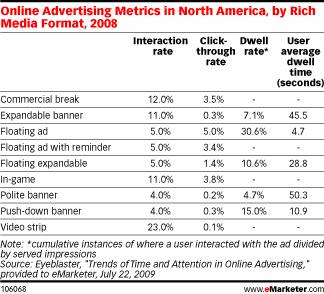
| Vol 1, #24, August 25, 2009 |
|
August 25 , 2009 Why click-throughs can't tell you how much time people really spend with ads A new report by Eyeblaster shows that users are 25 times more likely to engage with online advertising than to click on it. The study of over 42 billion rich media impressions highlights the importance of the ‘dwell’ time metric when measuring online ad success. Dwell time is the average number of seconds the user engaged with the ad, including mouse-on-ad, user initiated expansion, user-initiated video and timed custom interaction. Developed by Eyeblaster, an independent, global innovator in digital marketing, “dwelling” allows marketers to more thoroughly measure the full range of interaction that might take place with online advertising. “Recent research shows the lack of suitable metrics as a top frustration for marketers,” says Gal Trifon, CEO and founder of Eyeblaster. “Technology allows us to analyze consumer time spent with display advertising and indicates that consumers intentionally spend nearly a minute with online ads on average.” In their newly released report “Trends of Time and Attention in Online Advertising”, Eyeblaster showed that the difference between clicks and general interaction was huge in 2008. For example, the average worldwide click-through rate for rich media was 0.35 per cent while the average dwell rate for those ads was 8.71 per cent. “If advertisers are only looking at click-throughs they’re only seeing 0.35 per cent of the people coming through to their website but we know from our research that the majority of the conversions do not come from the click through – the majority come from post-conversion activity between 30-60 days after a consumer has engaged with their online creative,” says Mick O’Brien, Vice President of Eyeblaster. In North America, the report shows that expandable banners had only a 0.3 per cent click-through rate but a 7.1 per cent dwell rate and an average user dwell time of more than 45 seconds. The chart below shows a breakdown of how other forms of rich media performed across North America in 2008:
Other key findings from the report include:
|
Contact Us For rates, opportunities, media partnerships, or to other information please contact our media sales department. {p: 905-201-6600} {t: 1-800-668-1838} Mark Henry Sales Manager, x 224 Peter O'Desse Senior Account Manager, x 223 Steve Lloyd, Publisher, x 225 Amy Bostock, Editor, x 221 |
